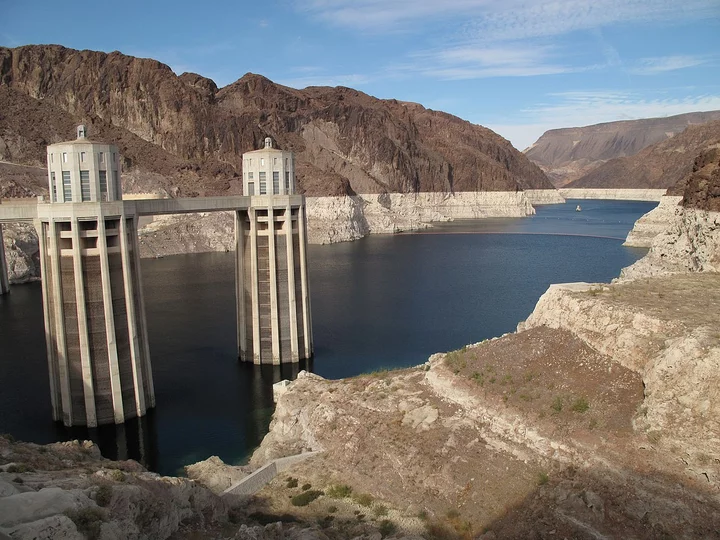Low water in Lake Mead in 2010. Photo: Cmpxchg8b, via Wikimedia. Public domain.
California and six other states that import water from the parched Colorado River failed to reach an agreement today on how to cut their use despite a deadline from federal officials.
Six states presented the federal government with a proposal to slash the lower basin’s use by 2.9 million acre-feet — including more than 1 million acre-feet from California, or 25% of its historic entitlements. But California, the largest user of Colorado River water, refused to sign onto the proposal and, instead, hours later issued its own — which mirrors its offer last fall to cut imports by 9%, or 400,000 acre feet.
The impasse is over water delivered to Imperial Valley farmers and cities in six Southern California counties.
A severe mega-drought — the driest conditions in 1,200 years — has forced the states to find ways to reduce their imports since they are now consuming far more water than the river contains: Allocations to the United States and Mexico based on historic rights total 16.5 million acre-feet a year, and in most years, they are using around 13 million acre-feet — significantly more than the river’s 11 million acre-feet. Its reservoirs are at record low levels and are expected to keep dropping.
U.S. Interior Department officials, who enforce the river’s allocations, did not weigh in on the proposals today or even mention the deadline. Spokesperson Tyler Cherry said in a statement that Interior “remains committed to pursuing a collaborative and consensus-based approach.” He called it the “strongest immediate tool” to reach an agreement to sustainably manage the river’s water supply.
The dispute pits the Imperial Irrigation District, the Metropolitan Water District, the Coachella Valley Water District, the Palo Verde Irrigation and the Quechan Tribal Council against Arizona, Nevada, Colorado, Wyoming, New Mexico and Utah. The Imperial Irrigation District is by far the largest user in California, with senior rights to 3.1 million acre-feet per year.
Imperial Valley growers have resisted fallowing their fields, saying they have rights to the water and already have cut their usage.
In a statement, JB Hamby, chairman of the Colorado River Board of California, said the proposal from the other states “is inconsistent with the Law of the River and does not form a seven-state consensus approach.” Hamby also serves as vice-president of the Imperial Irrigation District’s Board of Directors.
The Law of the River refers to the system of allocating water to each state based on decades-old agreements and court rulings. That process favors California, since its users have senior rights.
By importing Colorado River water, Imperial County has become the ninth largest agricultural producer in California, reporting $2.3 billion in sales in 2021, led by cattle and lettuce.
Alfalfa and other forage grasses — water-intensive crops used to feed dairy cows and cattle — dominate the acreage, carpeting more than half of the farmland. Imperial also produces two-thirds of the vegetables consumed in the U.S. during winter months.
Instead of signing the proposal from the other states, the Imperial Irrigation District and the other Southern California water agencies presented their own plan today. It closely resembles a similar offer they made in October to cut annual withdrawals by 400,000 acre-feet per year at least through 2026. That 9% reduction is much less than the 15% to 30% cuts that federal water managers are waiting for.
Hamby said California’s proposal is “based on what is practical, voluntary, and achievable through 2026 in a way that works within the existing body of laws, compacts, decrees, and … the Law of the River.”
The steep decline in the river’s supply has induced an escalating panic during the past five years. Last summer, Bureau of Reclamation Commissioner Camille Touton asked the states in the Colorado River basin for a plan to reduce use of the river’s water by 2 to 4 million acre-feet each year within 60 days. The soft deadline passed quietly. In December, Touton repeated the order at a water users conference in Las Vegas, calling on the seven states for a plan to cut their use of Colorado River water “before the end of January.”
Some water policy experts consider it fair for California to give up more water that it has agreed to since it uses the most. John Fleck, water policy expert at the University of New Mexico School of Law’s Utton Center, said the six-state proposal “broadly shares shortages across all the water users. California would prefer to stick with their interpretation of old legal agreements, because they come out on top.”
The six-state proposal suggests that lower basin states – California, Arizona and Nevada – plus Mexico cut their usage by 1.5 million acre-feet when the elevation of Lake Mead drops below 1,145 feet, to account for water lost to evaporation, which current allocation systems do not consider. Mead currently stands at 1,046 feet and by volume is three-fourths empty.
The proposal suggests further water cuts as the lake declines past specific trigger points. At a level below 1,020 feet, California would retain 3 million of its full 4.4 million acre-foot entitlement.
Fleck said past Colorado River water management has been hasty and haphazard.
“We’ve avoided legal conflict by just allowing California and Arizona to take a whole lot of water, and now Lake Mead is at these low levels,” he said.
Cuts have occurred in the past, he said, though usually with little impact on California. “They were the best we could do without triggering this sort of conflict,” Fleck said.
Now unrelenting drought, combined with overuse of the river, have taken things to the next level.
“What we’re seeing is a real manifestation of the urgent need to solve this problem, one way or another,” Fleck said.
###
CalMatters.org is a nonprofit, nonpartisan media venture explaining California policies and politics.

CLICK TO MANAGE